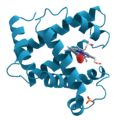Rhabdomyolysis facts for kids
Quick facts for kids Rhabdomyolysis |
|
|---|---|
| Symptoms | Muscle pains, weakness, vomiting, confusion, tea-colored urine, irregular heartbeat |
| Complications | Kidney failure, high blood potassium, low blood calcium, disseminated intravascular coagulation, compartment syndrome |
| Causes | Crush injury, strenuous exercise, medications, certain infections |
| Diagnostic method | Blood test (creatine kinase), urine test strip |
| Treatment | Intravenous fluids, dialysis, hemofiltration |
| Frequency | 26,000 reported cases per year (U.S.) |
Rhabdomyolysis (say "rab-doh-my-OH-lih-sis"), often called rhabdo for short, is a serious condition. It happens when damaged skeletal muscle (the muscles you use to move) breaks down very quickly. When muscle breaks down, it releases harmful substances into the blood. These substances can hurt your kidneys and other parts of your body.
Contents
What are the Signs of Rhabdo?
When someone has rhabdomyolysis, they might feel strong muscle pains and weakness. They could also feel sick to their stomach and throw up. Sometimes, people might feel confused or have an irregular heartbeat. A common sign is urine that looks like dark tea or cola. This dark color comes from a protein called myoglobin that is released from the damaged muscles. Myoglobin is especially bad for the kidneys.
What Causes Rhabdomyolysis?
Muscle damage that leads to rhabdomyolysis can happen for several reasons.
- Injuries: A common cause is a crush injury, like when a heavy object falls on a limb.
- Too Much Exercise: Very intense or long exercise, especially in hot weather, can also cause it. This is sometimes called exertional rhabdomyolysis.
- Medicines and Illnesses: Some medications can increase the risk. Certain infections, electric shocks, or heat stroke can also lead to rhabdo.
- Other Reasons: Staying in one position for a very long time, like after an accident, can also cause muscle damage. Sometimes, a snake bite can trigger it. Some people have inherited muscle conditions that make them more likely to get rhabdomyolysis.
Doctors can check for rhabdomyolysis with a urine test strip. This test might show "blood" in the urine, but when looked at closely, there are no red blood cells. Blood tests are also used to measure a substance called creatine kinase (CK). High levels of CK (over 1,000 U/L) suggest rhabdomyolysis. Very high levels (over 5,000-15,000 U/L) mean the condition is severe.
How is Rhabdo Treated?
The main way to treat rhabdomyolysis is by giving the patient a lot of IV fluids. These fluids help to flush out the harmful substances from the body and protect the kidneys. In more serious cases, doctors might use dialysis or hemofiltration. These are special treatments that help clean the blood when the kidneys are not working well.
If treated early, people with rhabdomyolysis usually get better. However, if not treated quickly, it can lead to serious problems. These can include kidney failure, high levels of potassium in the blood, or low levels of calcium.
How Common is Rhabdo?
Rhabdomyolysis is reported about 26,000 times each year in the United States. Doctors have known about this condition for a long time. The first modern descriptions came after a big earthquake in 1908. Important discoveries about how it works were made during the Blitz of London in 1941. It's a big concern for people injured in earthquakes, and medical teams often help survivors with rhabdomyolysis.
Rhabdo in Animals
Rhabdomyolysis can also affect animals, especially horses. Horses can get different muscle problems, and some of these can turn into rhabdomyolysis. For example, a lack of vitamin E and selenium in their diet can cause it. Some horses have a genetic condition called equine polysaccharide storage myopathy that makes them more likely to get rhabdo after exercise. About 5-10% of thoroughbred horses and some standardbred horses have a condition called equine exertional rhabdomyolysis. The exact cause isn't known, but it might involve how their muscles handle calcium.
Sometimes, rhabdomyolysis in horses can happen in groups, like an outbreak. This has been seen in many countries. It's sometimes called "atypical myopathy." The cause isn't always clear, but it often follows a seasonal pattern. Horses with this condition can have very high creatine kinase levels, and sadly, many do not survive.
Images for kids
-
This picture shows myoglobin, a protein that helps store oxygen in healthy muscles. But in rhabdomyolysis, it can harm the kidneys.
-
During the Blitz of London, doctors learned a lot about how kidney damage happens in rhabdomyolysis by studying injured people.
See also
 In Spanish: Rabdomiólisis para niños
In Spanish: Rabdomiólisis para niños





